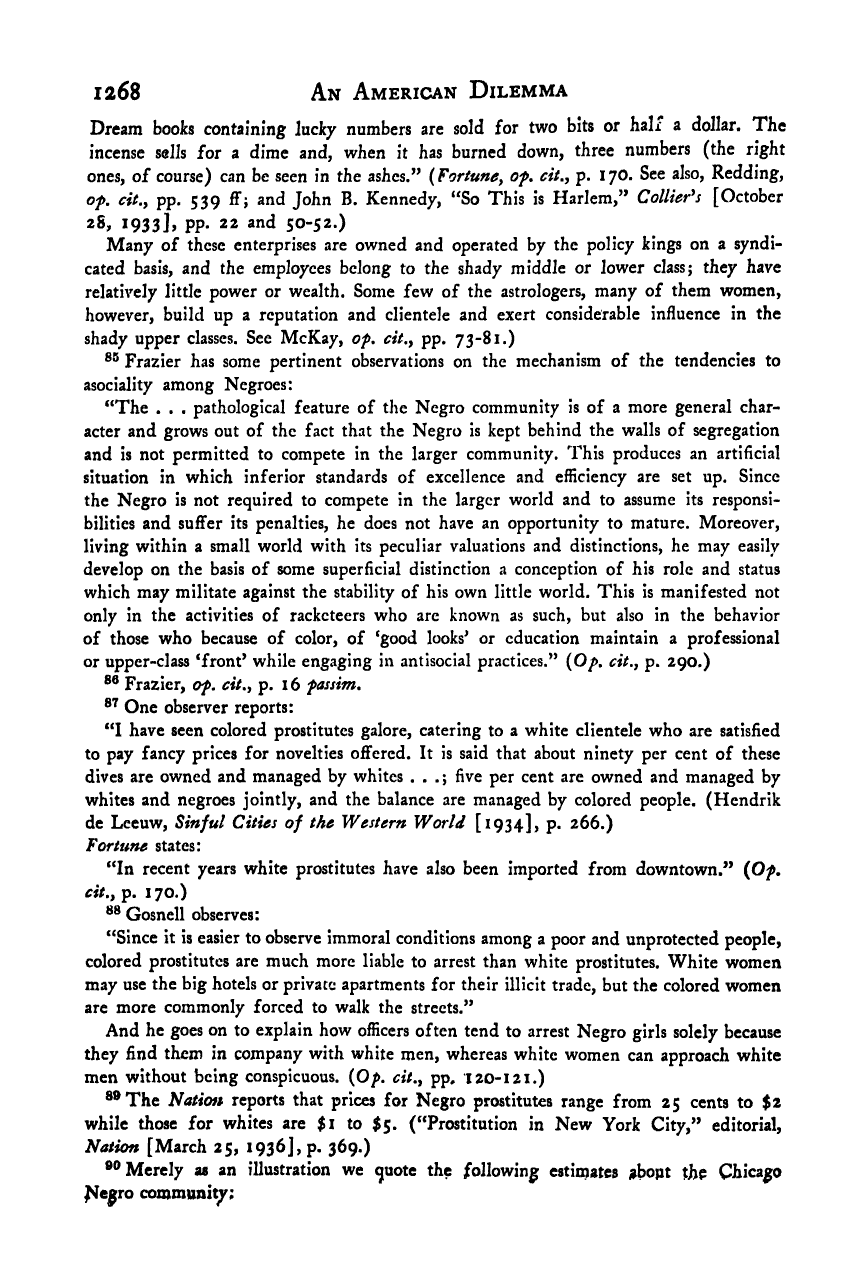Note: Gunnar Myrdal died in 1987, less than 70 years ago. Therefore, this work is protected by copyright, restricting your legal rights to reproduce it. However, you are welcome to view it on screen, as you do now. Read more about copyright.
Full resolution (TIFF) - On this page / på denna sida - Footnotes - Chapter 14

<< prev. page << föreg. sida << >> nästa sida >> next page >>
Below is the raw OCR text
from the above scanned image.
Do you see an error? Proofread the page now!
Här nedan syns maskintolkade texten från faksimilbilden ovan.
Ser du något fel? Korrekturläs sidan nu!
This page has never been proofread. / Denna sida har aldrig korrekturlästs.
1268 An American Dilemma
Dream boob containing lucky numbers are sold for two bits or hali a dollar. The
incense sells for a dime and, when it has burned down, three numbers (the right
ones, of course) can be seen in the ashes.” (Fortune, of, cit,, p. 17O. See also, Redding,
of, cit,y pp. 539 ff; and John B. Kennedy, “So This is Harlem,” Collier^
s
[October
28, I 933 ]> PP- 22 and 50-52.)
Many of these enterprises are owned and operated by the policy kings on a syndi-
cated basis, and the employees belong to the shady middle or lower class; they have
relatively little power or wealth. Some few of the astrologers, many of them women,
however, build up a reputation and clientele and exert considerable influence in the
shady upper classes. See McKay, of, cit,y pp. 73-81.)
Frazier has some pertinent observations on the mechanism of the tendencies to
asociality among Negroes:
“The . . .
pathological feature of the Negro community is of a more general char-
acter and grows out of the fact that the Negro is kept behind the walls of segregation
and is not permitted to compete in the larger community. This produces an artificial
situation in which inferior standards of excellence and efficiency are set up. Since
the Negro is not required to compete in the larger world and to assume its responsi-
bilities and suffer its penalties, he does not have an opportunity to mature. Moreover,
living within a small world with its peculiar valuations and distinctions, he may easily
develop on the basis of some superficial distinction a conception of his role and status
which may militate against the stability of his own little world. This is manifested not
only In the activities of racketeers who arc known as such, but also in the behavior
of those who because of color, of ‘good looks^ or education maintain a professional
or upper-class ‘front’ while engaging in antisocial practices.” {Of, cit,, p. 290.)
Frazier, of, cit,^ p. 1
6 fassim.
One observer reports:
“I have seen colored prostitutes galore, catering to a white clientele who are satisfied
to pay fancy prices for novelties offered. It is said that about ninety per cent of these
dives are owned and managed by whites . . .; five per cent are owned and managed by
whites and negroes jointly, and the balance are managed by colored people. (Hendrik
de Leeuw, Sinful Cities of the Western World [1934], p. 266.)
Fortune states:
“In recent years white prostitutes have also been Imported from downtown.” {Of,
Cit,y p. 170.)
®® Gosnell observes:
“Since it is easier to observe Immoral conditions among a poor and unprotected people,
colored prostitutes are much more liable to arrest than white prostitutes. White women
may use the big hotels or private apartments for their illicit trade, but the colored women
are more commonly forced to walk the streets.”
And he goes on to explain how officers often tend to arrest Negro girls solely because
they find them in company with white men, whereas white women can approach white
men without being conspicuous. {Of, cit,y pp, 120-121.)
®®The Natioft reports that prices for Negro prostitutes range from 25 cents to $2
while those for whites are $i to $5. (“Prostitution in New York City,” editorial.
Nation [March 25, 1936], p. 369.)
Merely as an illustration we <juote the following estimates abopt the Chicago
^egro community;
<< prev. page << föreg. sida << >> nästa sida >> next page >>